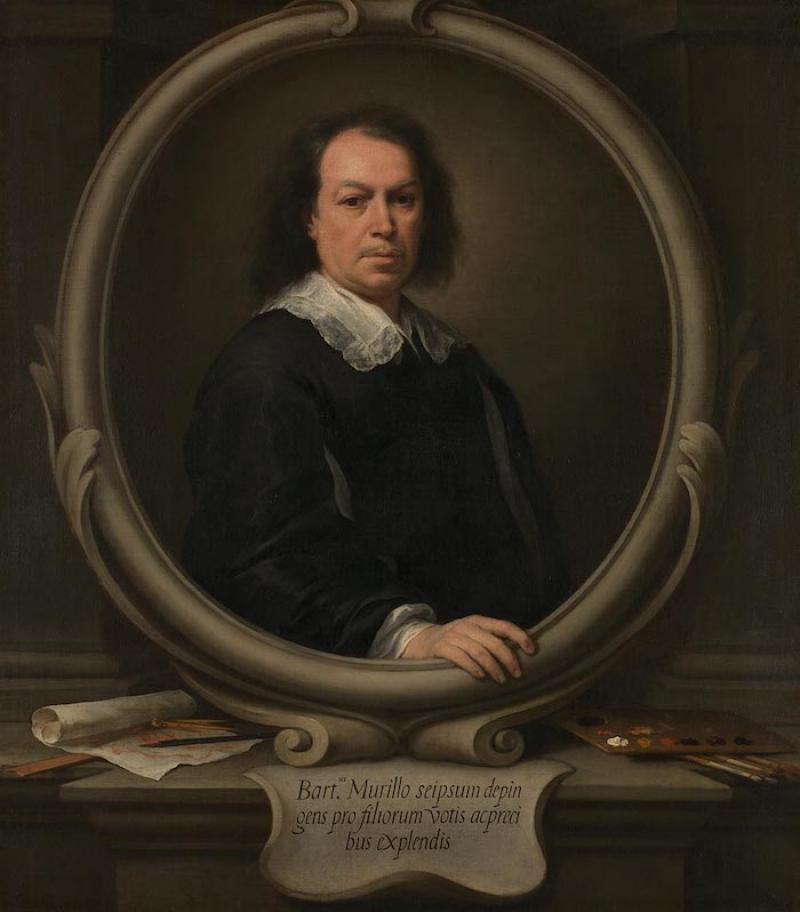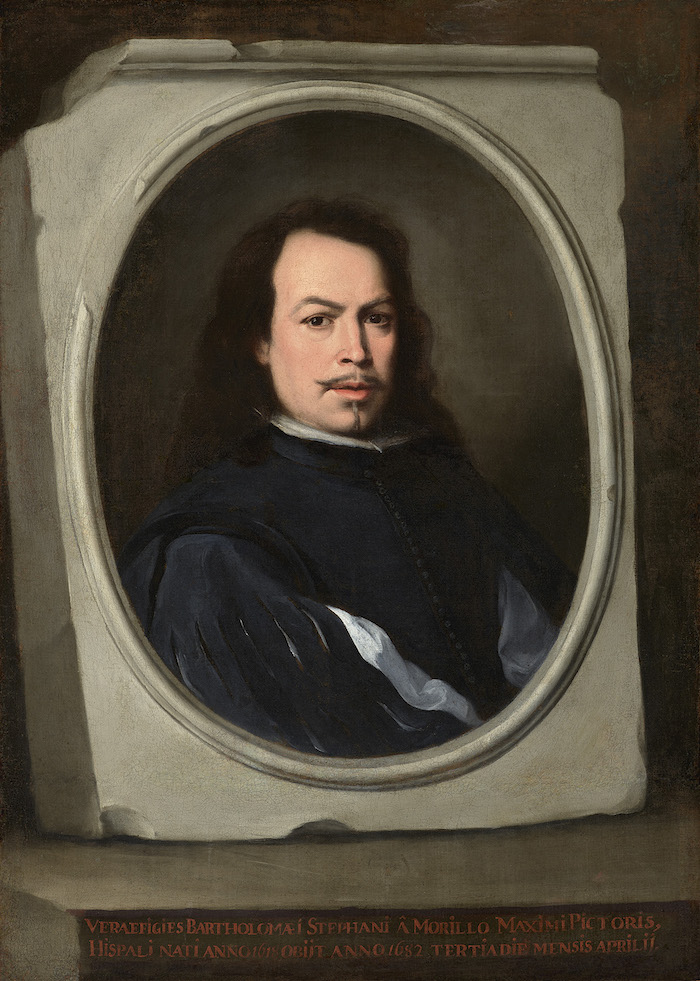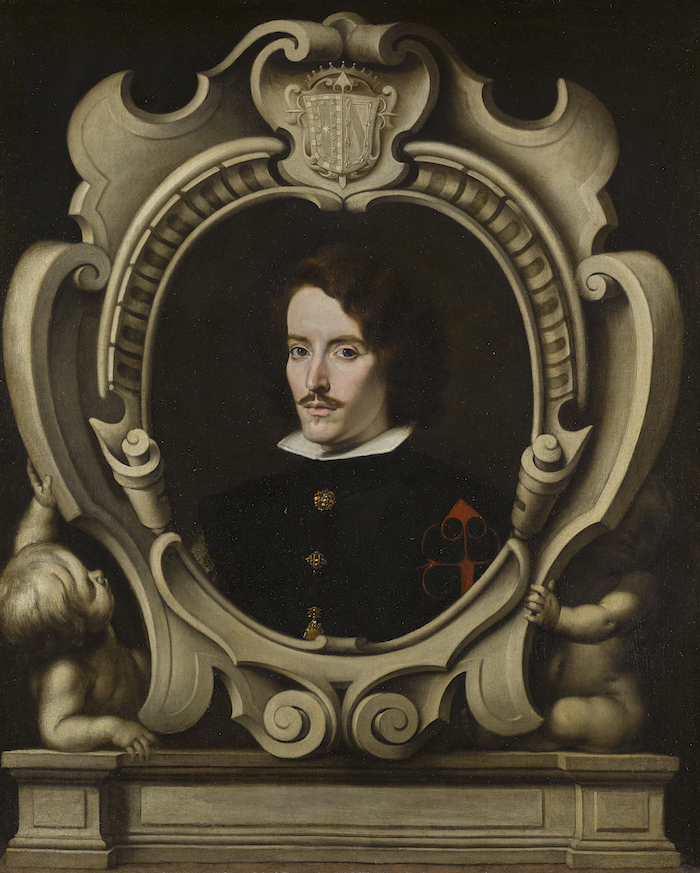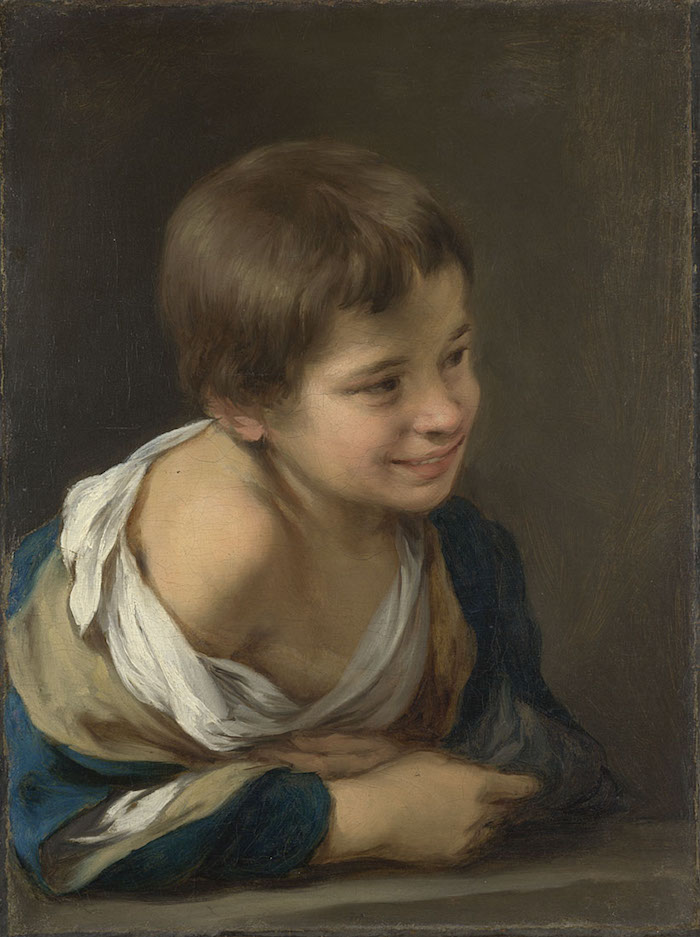Murillo: The Self-Portraits, National Gallery review - edged with darkness | reviews, news & interviews
Murillo: The Self-Portraits, National Gallery review - edged with darkness
Murillo: The Self-Portraits, National Gallery review - edged with darkness
Exquisite exhibition prompted by Murillo's two self-portraits considers what can survive time's wreckage

Mortality inflects commemoration. So it is with portraiture: the likeness – particularly those which celebrate lives of status and accomplishment – will always be limned with death.
The National Gallery’s tiny exhibition of Murillo’s two known self-portraits (Self-portrait, c. 1650-55 pictured below, and Self-portrait, c. 1670, main picture) – brought together for the first time since they were separated from the private collection of his son, Gaspar – is not only a tight and elegant reflection on Murillo’s art as he aged, but also a meditation on the purpose of portraiture and the way art carries messages across time. The single-room exhibition comprises eight paintings, an engraving, and three books displayed in a vitrine which posthumously commemorate Murillo’s work, and are held open at the pages displaying his portrait. Low lighting allows for the chiaroscuro of Murillo’s palette to punctuate the shadows and the division of his early work on one side of the room and later work on the opposite – each half clearly aligned with either the earlier or later self-portrait around which the exhibition has been constructed – draws sharp, if subtle, distinctions between his earlier, formally precise paintings, and his later, bolder work.
The single-room exhibition comprises eight paintings, an engraving, and three books displayed in a vitrine which posthumously commemorate Murillo’s work, and are held open at the pages displaying his portrait. Low lighting allows for the chiaroscuro of Murillo’s palette to punctuate the shadows and the division of his early work on one side of the room and later work on the opposite – each half clearly aligned with either the earlier or later self-portrait around which the exhibition has been constructed – draws sharp, if subtle, distinctions between his earlier, formally precise paintings, and his later, bolder work.
 To the left hang three portraits of young men painted in the early 1650s. Two bear Murillo’s distinctive interior stone frames, though to quite different effect. In Portrait of Juan Arias de Saavedra, 1650, little putti with distinctive button noses hold upright the family coat of arms, while in Portrait of Count Diego Ortiz de Zúñiga, 1655 (pictured right) one crawls out from behind the ogive to peer into the Count’s young, idealised face as if entranced by his preternaturally marmoreal features; another little putto seems anxious to escape the gloom behind the painted stone frame. In the third portrait, Young Man, 1650-1655, the paint is more freely handled and the boy appears more approachable, warm in his demeanour, though this may also be due to the vulnerability of impending adolescence, traces of which shadow his jaw and upper lip.
To the left hang three portraits of young men painted in the early 1650s. Two bear Murillo’s distinctive interior stone frames, though to quite different effect. In Portrait of Juan Arias de Saavedra, 1650, little putti with distinctive button noses hold upright the family coat of arms, while in Portrait of Count Diego Ortiz de Zúñiga, 1655 (pictured right) one crawls out from behind the ogive to peer into the Count’s young, idealised face as if entranced by his preternaturally marmoreal features; another little putto seems anxious to escape the gloom behind the painted stone frame. In the third portrait, Young Man, 1650-1655, the paint is more freely handled and the boy appears more approachable, warm in his demeanour, though this may also be due to the vulnerability of impending adolescence, traces of which shadow his jaw and upper lip.
To the right are paintings from the later years. The portraits in this selection are more frank and personal. That of Murillo’s great friend and patron, Portrait of Nicolás Omazur, 1672, is starkly allegorical. Omazur carries a skull, the fingers of his left hand gently caressing the cranium as if he could feel thought through the bone, while the right cups the occiput easily; but it’s the texture of his gaze that’s striking, as if he’s been caught mid-thought and is aware he is being observed but unwilling to meet his viewer’s eyes.
 Murillo’s ability to portray these most fleeting of expressions is displayed too in the small painting adjacent of a street urchin smiling out at something beyond the frame (A Peasant Boy Leaning on a Sill, c. 1675, pictured left). It’s a smile that reaches to his eyes and pulls up his shoulders to his neck in pure joy – a fizz of happiness enlivening a moment like the sun coming out and quite possibly as quickly dissipated. In its impermanence it shares something with the early portraits, namely an understanding of the speed with which the phenomena that constitute life disperse. But whereas the early portraits seem to vye with mortality and aim for remembrance across the ages, the later works embrace this impermanence and respect, if not revel, in it.
Murillo’s ability to portray these most fleeting of expressions is displayed too in the small painting adjacent of a street urchin smiling out at something beyond the frame (A Peasant Boy Leaning on a Sill, c. 1675, pictured left). It’s a smile that reaches to his eyes and pulls up his shoulders to his neck in pure joy – a fizz of happiness enlivening a moment like the sun coming out and quite possibly as quickly dissipated. In its impermanence it shares something with the early portraits, namely an understanding of the speed with which the phenomena that constitute life disperse. But whereas the early portraits seem to vye with mortality and aim for remembrance across the ages, the later works embrace this impermanence and respect, if not revel, in it.
It’s this shift in Murillo’s understanding of what constitutes life and death that is the pivot of the exhibition. Between the two self-portraits is a hinge. To the left is a young, confident, rakish young man who meets his viewers’ eyes with bombast and challenge. To the right is the older man, revered as a great artist but knocked, perhaps, by circumstance. His circumspect glance doesn’t quite meet ours but slides to the side, as if aware of company but more taken by his own thoughts.
If as a young man Murillo appeared assured of his ability to project his own image into the future, in later life he portrays himself as wiser, able to see beyond his painted frames to the darker edges.
- Murillo: The Self Portraits at the National Gallery until 21 May, free
- Read more visual arts reviews on theartsdesk
rating
Share this article
more Visual arts
 Fantastic Machine review - photography's story from one camera to 45 billion
Love it or hate it, the photographic image has ensnared us all
Fantastic Machine review - photography's story from one camera to 45 billion
Love it or hate it, the photographic image has ensnared us all
 Yinka Shonibare: Suspended States, Serpentine Gallery review - pure delight
Weighty subject matter treated with the lightest of touch
Yinka Shonibare: Suspended States, Serpentine Gallery review - pure delight
Weighty subject matter treated with the lightest of touch
 Jane Harris: Ellipse, Frac Nouvelle-Aquitaine MÉCA, Bordeaux review - ovals to the fore
Persistence and conviction in the works of the late English painter
Jane Harris: Ellipse, Frac Nouvelle-Aquitaine MÉCA, Bordeaux review - ovals to the fore
Persistence and conviction in the works of the late English painter
 Sargent and Fashion, Tate Britain review - portraiture as a performance
London’s elite posing dressed up to the nines
Sargent and Fashion, Tate Britain review - portraiture as a performance
London’s elite posing dressed up to the nines
 Zineb Sedira: Dreams Have No Titles, Whitechapel Gallery review - a disorientating mix of fact and fiction
An exhibition that begs the question 'What and where is home?'
Zineb Sedira: Dreams Have No Titles, Whitechapel Gallery review - a disorientating mix of fact and fiction
An exhibition that begs the question 'What and where is home?'
 Yoko Ono: Music of the Mind, Tate Modern review - a fitting celebration of the early years
Acknowledgement as a major avant garde artist comes at 90
Yoko Ono: Music of the Mind, Tate Modern review - a fitting celebration of the early years
Acknowledgement as a major avant garde artist comes at 90
 Unravel: The Power and Politics of Textiles in Art, Barbican review - the fabric of dissent
An ambitious exploration of a neglected medium
Unravel: The Power and Politics of Textiles in Art, Barbican review - the fabric of dissent
An ambitious exploration of a neglected medium
 When Forms Come Alive, Hayward Gallery review - how to reduce good art to family fun
Seriously good sculptures presented as little more than playthings or jokes
When Forms Come Alive, Hayward Gallery review - how to reduce good art to family fun
Seriously good sculptures presented as little more than playthings or jokes
 Entangled Pasts 1768-now, Royal Academy review - an institution exploring its racist past
After a long, slow journey from invisibility to agency, black people finally get a look in
Entangled Pasts 1768-now, Royal Academy review - an institution exploring its racist past
After a long, slow journey from invisibility to agency, black people finally get a look in
 Barbara Kruger, Serpentine Gallery review - clever, funny and chilling installations
Exploring the lies, deceptions and hyperbole used to cajole, bully and manipulate us
Barbara Kruger, Serpentine Gallery review - clever, funny and chilling installations
Exploring the lies, deceptions and hyperbole used to cajole, bully and manipulate us
 Richard Dorment: Warhol After Warhol review - beyond criticism
A venerable art critic reflects on the darkest hearts of our aesthetic market
Richard Dorment: Warhol After Warhol review - beyond criticism
A venerable art critic reflects on the darkest hearts of our aesthetic market
 Dineo Seshee Raisibe Bopape: (ka) pheko ye / the dream to come, Kiasma, Helsinki review - psychic archaeology
The South African artist evokes the Finnish landscape in a multisensory installation
Dineo Seshee Raisibe Bopape: (ka) pheko ye / the dream to come, Kiasma, Helsinki review - psychic archaeology
The South African artist evokes the Finnish landscape in a multisensory installation

Add comment